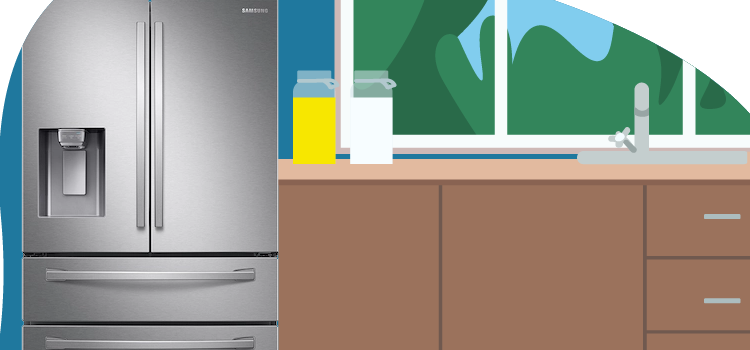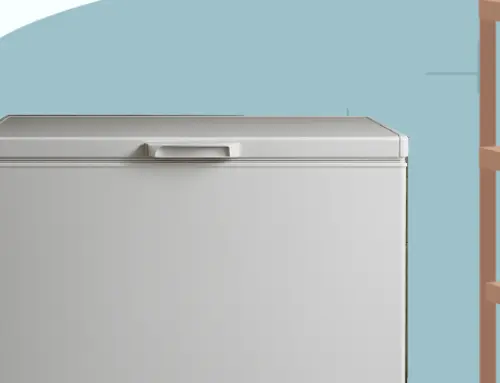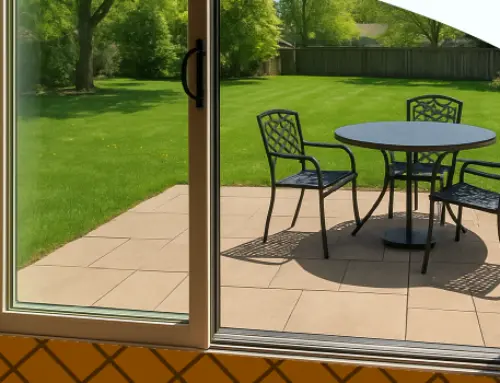What Is the Average Temperature of a Refrigerator?
by Tyler Castle
18.8 min read

You open the refrigerator for a cold drink or a crisp apple, only to find milk that's starting to sour or lettuce that's frozen solid. Sound familiar?
It's one of the most common frustrations homeowners face when trying to determine the ideal refrigerator temperature. Too warm, and food spoils quickly. Too cold, and groceries freeze or energy bills rise higher than expected.
The truth is that refrigerator settings aren't always as simple as turning the dial to the middle. Different models, where you store your food, how often the door is opened, and even weather conditions can all affect your fridge's temperature.
In this blog, we'll clear up the confusion by explaining the average refrigerator and freezer temperatures you should aim for. We'll also share practical tips to help you keep your fridge running efficiently, keep your food fresher for longer, and control your energy costs.
Let's get your fridge working smarter so you can stop worrying and start saving!
Key Points of This Article:
- Throw out perishable food left above 40°F for more than 2 hours; bacteria multiply fast at this temperature.
- Check your fridge and freezer temperatures regularly with an appliance thermometer to keep food safe and energy use steady.
- Clean condenser coils every 6 months to help your refrigerator cool efficiently and prevent energy waste.
- Avoid setting your refrigerator colder than needed. Every degree lower uses more power and raises your electric bill.
What Is the Average Temperature of a Refrigerator?
If you're not sure what the average temperature for your refrigerator is, you're not alone! In a recent survey, 42% of employee-owners at Santanna Energy Services didn't know the average temperature for their refrigerator either!
Most homeowners are surprised to learn that even a difference of a few degrees can determine whether food stays safe or spoils too soon. According to the U.S. Food and Drug Administration (FDA), the average temperature of a refrigerator should be 40°F (4.4°C) or below.
At this range, your fridge is cold enough to slow the growth of harmful bacteria while still preventing your produce and drinks from freezing. This is important because bacteria such as Salmonella and E. coli multiply quickly when food is stored above 40°F. That means milk kept in a fridge that's too warm may spoil days earlier than expected, and leftovers could become unsafe to eat even if they look fine.
However, if your fridge runs too cold, closer to 32°F, you might end up with frozen lettuce, cracked eggs, and wasted groceries. It's also worth noting that the temperature shown on your fridge dial doesn't always reflect the actual conditions inside. Cold air settles toward the back, while the door area warms up each time it's opened.
Because of this, the U.S. Department of Agriculture (USDA) recommends placing an appliance thermometer inside your fridge to make sure it consistently stays within the safe range for freshness, safety, and efficiency.
Factors That Affect Refrigerator Temperature Readings
Even if your refrigerator is set to the “right” number, the actual temperature can shift because of everyday factors. Here’s how each one affects your fridge’s temperature:
1. Thermostat Accuracy
Built-in dials or digital panels don’t always measure the true air temperature inside your refrigerator. They often read the cooling cycle instead of the actual food storage areas.
For example, your fridge might display 37°F, but a thermometer placed inside could show 40°F near the door or 34°F near the back wall. This mismatch makes it difficult to rely on the display alone.
2. Fridge Placement in Your Kitchen
Where you position your refrigerator affects how well it maintains its temperature. A fridge placed next to an oven, under direct sunlight, or pressed too tightly against a wall must work harder to stay cool.
External heat raises the internal temperature, which means that even though your settings remain the same, the fridge may struggle to maintain them. This often results in warmer readings than expected.
3. Frequency of Door Openings
Every time you open the refrigerator door, warm kitchen air enters and mixes with the cold air inside. The more often this happens, the more temperature spikes you’ll see.
A thermometer near the front may show quick jumps in temperature, while the back remains cooler. This creates uneven readings throughout the refrigerator and affects how evenly your food is cooled.
4. Seasonal and Regional Factors
Seasonal changes can also impact how your refrigerator performs. Hot, humid weather, especially common during Midwest summers, forces refrigerators to cycle more often to stay cool. Older models can struggle to keep up with these demands.
During a heat wave, you might notice that your fridge’s temperature rises higher than normal, even if you haven’t adjusted the settings. A refrigerator that usually stays steady at 37°F might creep closer to 40°F or more.
How to Change the Temperature on a Refrigerator
Not every fridge works the same way, but the process for changing the temperature is similar across most models. Here’s a general guide you can follow:
1. Find the Control Panel or Dial
Look for the temperature control, either inside the refrigerator near the top or back wall, or on a digital panel at the front. If your fridge uses a dial, note that the numbers usually run from 1 (warmest) to 7 (coldest). These settings are not exact temperatures, so you’ll need to test and fine-tune.
2. Adjust in Small Steps
Turn the dial one level colder or warmer, or use the digital arrows to change it by one degree. Small changes work best. After adjusting, give your refrigerator at least 24 hours to stabilize before deciding if it needs another tweak.
3. Use a Thermometer to Verify
Place an appliance thermometer on a middle shelf to see the true temperature. The goal is to keep your refrigerator between 37 and 40°F and your freezer at 0°F. This is the safe zone for food freshness and energy efficiency.
4. Watch for Signs It’s Off
Pay attention to how your food reacts. If lettuce or drinks start freezing, your fridge is too cold. If milk or leftovers spoil quickly, it’s too warm. Make small adjustments until your food stays fresh without freezing.
5. Check Your Manual
Check your refrigerator’s manual for any special settings. Some models have features like “Quick Cool,” “Power Freeze,” or “Energy Saver” that can change how the temperature behaves. Knowing what each button does helps you avoid overcooling or wasting energy.
Tip: If you no longer have the manual, most manufacturers have free PDFs on their websites. Search your brand + model number to find instructions.
What Is the Ideal Temperature for a Freezer?
According to the U.S. Department of Energy, your freezer should be set at 0°F (-18°C) to keep food safely frozen without wasting extra energy. The FDA explains that while freezing doesn’t kill bacteria, it does stop them from growing, which makes meat, poultry, and leftovers safe for long-term storage.
Setting your freezer colder than 0°F won’t improve food safety but will raise your electric bill, and it can also make items like ice cream turn rock hard. For the best results, keep your freezer at 0°F and use a thermometer to confirm the actual temperature, since built-in dials aren’t always accurate.
It’s also important to know that how you use your freezer affects its ability to stay at the right temperature. A freezer that’s too empty warms up quickly when the door is opened, while a freezer that’s overstuffed can block air circulation and create warm spots where food may not stay fully frozen.
Aim to keep it about three-quarters full for the best balance. During power outages, a full freezer can maintain food safety for up to 48 hours (or about 24 hours if half full), as long as the door stays closed.
How To Change the Temperature on a Samsung Fridge
Adjusting the temperature on a Samsung refrigerator depends on the model you have, but the process is straightforward once you know where to look. Here’s how to change the temperature on different Samsung models:
Family Hub Models
These smart fridges let you adjust settings digitally. You can change the temperature directly on the screen, or use the SmartThings app (or the older Fridge Manager app) to make adjustments from your phone.
Models with Fridge and Freezer Buttons
On these models, just press the Fridge or Freezer button repeatedly until you reach the temperature you want. Each press lowers the temperature by one step, and when you hit the lowest setting, it cycles back to the highest. Many of these refrigerators also feature a Power Cool or Power Freeze option, which allows for faster cooling when needed.
Models with Arrow Buttons
These fridges have a small control panel. Use the left or right arrows to scroll through Fridge, Freezer, or FlexZone settings. Press the “O” (OK) button to select, then use the arrows again to adjust to your desired temperature. Press “O” again to confirm. It can take a little time for the refrigerator to stabilize at the new setting.
Top Freezer and Upright Freezer Models
On these models, the freezer can sometimes double as an extra fridge. To change it, hold down the Freezer Convert button or the Fridge On/Off button for about three seconds to switch modes.
Tip: No matter which Samsung model you own, always double-check with an appliance thermometer to make sure the temperature inside matches the safe ranges: 37–40°F for the fridge and 0°F for the freezer.
Do Mini-Fridges Have Different Temperature Needs?
No, mini-fridges follow the same safe temperature range as full-sized refrigerators. Keep the temperature between 37–40°F for the fridge and 0°F for the freezer.
Because mini-fridges often have uneven cooling and warmer spots near the door, it’s best to use an appliance thermometer to make sure the temperature stays consistent and your food stays safe.
Standard Fridge vs. Mini-Fridge: Key Temperature Differences
|
|||||||||||||||||||
|---|---|---|---|---|---|---|---|---|---|---|---|---|---|---|---|---|---|---|---|
When to Adjust Temperatures Seasonally
Your refrigerator doesn’t actually keep the same temperature all year, even if the settings never change. In the summer, when the weather is hot and humid, your refrigerator has to work harder to stay cool. Every time you open the door, warm air rushes in and pushes the temperature up. If your thermometer starts showing anything above 40°F, try lowering your fridge setting by just one degree to help it stay in the safe zone.
In the winter, it can go the other way, especially if your refrigerator is in a cold garage, basement, or another unheated space. When the room temperature drops too low, your fridge may not run as often as it should. That can cause the freezer to warm up or make the fridge section too cold, sometimes even freezing your fruits and vegetables.
The U.S. Food and Drug Administration (FDA) recommends keeping your refrigerator at 40°F (4.4°C) or below and your freezer at 0°F (-18°C) year-round. Instead of guessing, check your fridge with a simple appliance thermometer a few times a year, especially at the start of each season, to make sure it’s still right where it should be.
How Often Should I Check My Refrigerator Temperature?
Even if you’ve set your fridge dial or digital panel, the actual temperature inside can shift from day to day. That’s why it’s recommended to occasionally check your refrigerator and freezer temperatures with an appliance thermometer. This helps ensure your fridge stays in the safe zone of 37–40°F for the refrigerator and 0°F for the freezer.
It’s also smart to check often during seasonal changes, since hot summers or freezing winters can make your fridge work harder. Always recheck after power outages, too, or anytime you notice signs that something’s off like milk souring early, vegetables freezing, or food spoiling faster than usual. Keeping an eye on the temperature helps prevent waste, saves energy, and ensures your fridge is doing its job.
Does Lowering My Fridge Temperature Increase My Electric Bill?
The short answer is yes; lowering your refrigerator temperature below the recommended range generally requires more power, which means higher energy consumption. Since refrigerators run all day, that extra energy quickly adds to your monthly bill.
It is recommended to keep your refrigerator at 37 to 40°F and your freezer at 0°F. This range is cold enough to keep food safe and fresh. Setting your refrigerator below these safe limits does not improve food safety and only wastes electricity. In fact, running it too cold can cause milk, vegetables, and drinks to freeze, leading to food waste and higher energy bills.
The bottom line is to stick with the recommended sweet spot. It protects your groceries, saves energy, and helps your refrigerator last longer. Going colder than needed only shortens the life of your appliance and raises your power bill without adding any real benefit.
How to Keep Your Fridge and Freezer Cool Efficiently and Save Energy
Your refrigerator runs 24/7, making it one of the largest energy users in your home. Keeping it efficient not only saves energy but also helps food stay fresh longer. Here’s how to keep your fridge and freezer cool efficiently:
1. Allow Airflow Inside
Cold air needs to circulate freely inside your refrigerator to maintain consistent temperatures. When shelves are overcrowded, cold spots and warm spots can develop, making it harder for your refrigerator to maintain an even temperature. Try to keep your fridge about three-quarters full, not packed too tightly but not nearly empty either. If it’s too empty, you can add a few jugs of water to help maintain a steady temperature.
2. Clean Condenser Coils
Unplug your fridge and gently vacuum or brush the condenser coils, which are usually found on the back or bottom. Dust and dirt buildup make the motor work harder and waste energy. Cleaning the coils at least every 6 months helps your fridge maintain steady cooling and run more efficiently.
3. Check Door Seals
Inspect the rubber gasket around the door to make sure it’s tight and flexible. If it’s cracked or loose, cold air escapes and warm air gets in, forcing the compressor to run longer. Try the “dollar bill test”—close a bill in the door and pull it out. If it slides easily, it’s time to replace the seal.
4. Keep the Right Fill Levels
Organize your food so the fridge isn’t overloaded or nearly empty. A too-full fridge blocks airflow, while an empty one warms up quickly every time you open the door. Keep it about three-quarters full for balance. For freezers, aim for fuller storage since frozen items help maintain the cold.
5. Let Hot Food Cool First
Before storing hot soup or leftovers, let them cool on the counter for about 30 minutes. Placing hot food directly in the fridge raises the internal temperature and forces the compressor to run longer, using more energy.
6. Maintain the Right Surroundings
Position your fridge in a spot where it can breathe. Avoid placing it next to heat sources like ovens, dishwashers, or direct sunlight. Leave a few inches of space behind and above the unit so air can circulate and heat can escape easily.
Where Is the Coldest Spot in Your Refrigerator?
The coldest spot in most refrigerators is at the back, near the bottom. Cold air sinks and stays trapped there, while the door and front shelves warm up every time you open it. That’s why milk, eggs, and meat last longer when stored toward the back instead of in the door.
Modern frost-free fridges circulate air for more even cooling, but the back remains the most consistent temperature zone. To make sure these areas stay in check with the rest of the fridge:
- Use an Appliance Thermometer: Place one in both the middle and the back of the fridge to monitor if the difference is too big.
- Don’t Block Vents: Cold air comes from the vents, usually near the back. Keep items a few inches away so air can circulate.
- Rotate Food: Move items around occasionally, so nothing sits too long in extreme cold spots and freezes.
- Keep the Fridge Balanced: Avoid overloading shelves, but don’t leave it nearly empty either. A fridge that’s about three-quarters full holds cold more evenly.
- Check Seals and Coils: Warm spots in the door plus cold spots in the back can be a sign your fridge is working too hard. Clean the coils and make sure the door seals tightly.
Common Problems & Troubleshooting Temperature Issues
Even when your fridge is set correctly, things can still go wrong. Here are some of the most common issues homeowners face and what they can mean:
- Food Spoiling Too Quickly: If milk sours or leftovers go bad before their time, your fridge may be running warmer than 40°F. Check with a thermometer and adjust settings.
- Frozen Produce or Drinks: Vegetables icing over or beverages turning slushy usually mean the fridge is too cold (closer to 32°F). Adjust settings slightly warmer and move produce away from the back wall.
- Uneven Cooling: Warm spots at the front and cold spots in the back are normal, but extreme differences can mean blocked vents or overcrowding. Leave space for air to circulate.
- Temperature Fluctuations After Door Openings: Frequent in-and-out traffic brings in warm air. Store sensitive foods (like milk and eggs) inside the fridge, not in the door, where temperatures swing the most.
- Overloaded Shelves: A packed fridge blocks air circulation, causing warm and cold pockets. Keep it about ¾ full for best performance.
- Not Enough in the Fridge: Believe it or not, a nearly empty fridge doesn’t hold cold as well. Cold food acts like insulation, so an underfilled fridge can warm up faster.
- Dirty Condenser Coils: Dusty or clogged coils make the compressor work harder, leading to higher internal temperatures. Cleaning coils twice a year helps keep temperatures stable.
- Faulty Door Seals (Gaskets): If the door doesn’t close tightly, cold air escapes and warm air gets in. Do a quick test by closing a dollar bill in the door. If it slides out easily, the seal may need replacing.
- Incorrect Placement in the Kitchen: A fridge next to an oven, in direct sunlight, or pushed against a wall may struggle to keep cool. Leave space around it for airflow and avoid hot spots.
- Old or Failing Components: Older fridges or ones with failing compressors, fans, or sensors may no longer maintain safe temperatures. If food still spoils despite adjustments, it may be time to repair or replace.
- Power Outages or Surges: Even short outages can cause temperatures to rise above 40°F. Always check the temperature with a thermometer after the power returns and discard food if it is unsafe.
- Freezer Not Staying at 0°F: If the freezer isn’t maintaining its temperature, check if it’s overloaded or if frost buildup is blocking airflow. Defrosting may help, but persistent issues could need a service call.
FAQs
Is 42°F safe for a refrigerator?
No. According to the FDA, bacteria grow rapidly above 40°F. A fridge at 42°F increases the risk of foodborne illness.
How long does food last in a refrigerator at the right temperature?
At 37–40°F, leftovers typically last 3–4 days, raw poultry or ground meat last 1–2 days, and most dairy products last 1 week or more. Keeping the fridge at the right temperature slows bacterial growth.
How do I know if my fridge is too full to cool properly?
If cold air can’t circulate, temperatures rise unevenly. Signs include food freezing in the back while spoiling in the front, or milk souring early. Leave space between items to allow air to flow.
Do older refrigerators need colder settings?
Not necessarily, but older models may lose efficiency. They can drift above 40°F even when set correctly, so checking with a thermometer is key.
Should I change my refrigerator temperature in summer?
Yes, in very hot, humid conditions (common in the Midwest), setting the fridge 1 degree colder can help keep food within the safe zone.
What should I do if the power goes out to avoid food spoiling?
Keep fridge and freezer doors closed. A closed fridge keeps food safe for about 4 hours; a full freezer maintains temperatures for 48 hours (24 hours if half full). Discard perishable food that has been above 40°F for 2 hours or more.
Should I replace or repair my refrigerator if it’s not keeping food cold enough?
If temperatures stay above 40°F despite cleaning coils, checking seals, and adjusting settings, repair or replacement may be needed. Consider replacing units older than 10–15 years, as they use more energy.
Do smart fridges automatically adjust to the average temperature?
Many smart fridges use sensors to detect internal changes (like door openings or warm food). They adjust cooling cycles automatically, but you should still verify the temperature with a thermometer.
Keeping your refrigerator at the right temperature may seem like a small detail, but it makes a big difference. By storing items in the right spots, checking temperatures regularly, and maintaining your appliance, you’ll cut down on food waste and avoid unnecessary energy costs.
If you live in the Midwest, these habits are even more important because hot, humid summers and cold winters put extra strain on refrigerators. Pairing smart appliance use with Santanna’s Unlimited Energy plan gives you predictable supply charges* and peace of mind, no matter the season. Set the right temperatures, save energy, and enjoy knowing both your fridge and your energy plan are working for you.
* Restrictions apply. Enrollment based upon program eligibility. Customers using more than 125% of normal monthly usage as determined by Santanna may be required to switch plans.
Tyler is an experienced energy professional, having worked for Santanna Energy Services, for the past four years. He is passionate about renewable energy and believes that diversifying the energy grid is the key to a sustainable future. Tyler is dedicated to supplying consumers with the best possible energy solutions and works diligently to make sure that Santanna can deliver the highest quality service.







